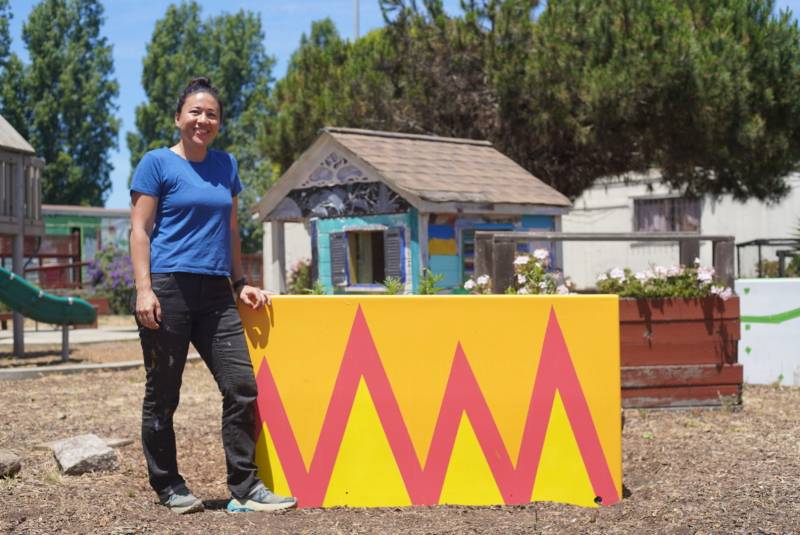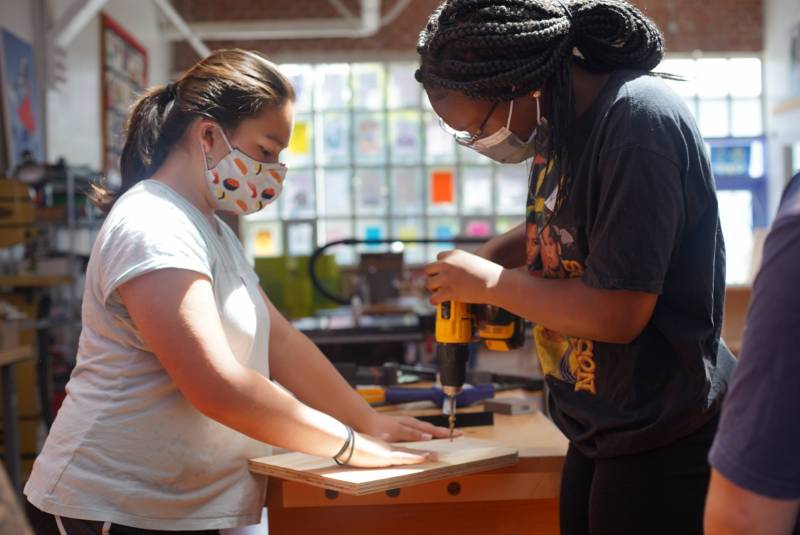Bookcases and bird feeders take shape amid the whir of chop saws, the bang of hammers and the trill of drills. Behind the power tools are girls and non-binary young folks, mostly in high school and middle school, but the youngest builders start at age 9.

They’re all students at West Berkeley’s Girls Garage, which was founded by Emily Pilloton-Lam in 2013. The organization’s mission is to make sure the young apprentices have the physical and metaphorical tools to get the job – any job – done.
This week, we’re back to talking to people in-person for the first time in over a year. And what better way to get out there than to jump into the saw dust and discuss all that comes from the process of building.
Below are lightly edited excerpts of my conversation with Emily Pilloton-Lam.
Emily: One of the first tools that we teach is the chop saw or the miter saw. The one we have is a 12 inch blade. That’s a blade that’s bigger than your 9-year-old head. And that’s actually a really important thing for us: I want to welcome young people by inviting them to do things that they’re scared of…
Pen: First day in… chop saw? Goodness…
Emily: I do feel like bravery is a thing that can be practiced. It’s a muscle that can be flexed. And so I want young people to have that experience of being afraid and of having someone standing next to you saying, you can do it. And every time you do it, it becomes less scary, to the point where you feel like an expert and where you can actually pass that on to others.
Pen: What do you actually build?
Emily: We build everything from small-scale — sort of practice projects — like a birdhouse or a catapult. We use those small projects as stepping stones to get to full-scale design build projects for our community. And so examples of that are a 500 square foot chicken coop for Urban Tilth, which is an urban farm in North Richmond, sandboxes for local preschools. This summer we’re building a greenhouse for a middle school. And so it’s important that our projects are beautiful, well engineered structures that we want to live on for years and serve our community in really specific ways.
Pen: How do you choose what community partners you work with?
Emily: We like to work with community partners who are really on the ground, direct aid, mutual aid models. And so if we can build you bookshelves or a chicken pavilion at no cost to you, then we’re able to sort of double our impact within the nonprofit sector in the Bay Area.
Pen: Beyond talking about the social and ethical issues that come up, how do you actually teach students hands on skills especially when students have different needs and learning styles?
Emily: This is actually why I think design and building and construction is such a great activity for young people, because in some ways it’s the great equalizer. There are things that are very precise and there are things that are not that are a lot more just creative and art based. Like, if I’m really good at math, there’s a way to approach building a birdhouse. That’s very math specific. Let’s get all the dimensions right. Let’s get everything all lined up. If I’m more of a sort of abstract visual learner, then let’s do a crazy sketch and let’s figure out how to make that thing happen. There’s a sound component we teach like how to listen to your tools to know what’s going right and going wrong. I think there’s so many different ways to teach building. So to me, I think this is the perfect medium. It is really an invitation for anyone who learns in any way who’s interested in anything, like I’ll find a place for you in this project.
Pen: On top of having that skill set in their metaphorical tool toolbox, they walk out the door with a literal toolbox as well?
Emily: They do, yes! we want to give something to girls that they can take with them when they’re not physically in our space, so that as they grow up and identify as builders and they’re at home and something breaks or they think, oh, I want to build a bookshelf, that they have the literal tools to do that. And so every teen girl who’s in our program is gifted a toolbox that’s about the size of a picnic cooler. It’s huge and it has twenty something tools in it.
Emily: The accumulation of the tools and the equipping yourself is often the barrier. It’s a financial barrier or a resource barrier. And so by providing this toolbox, we’re just removing that barrier and saying you have everything you need. Maybe you have to Google something, but you got this.

Rightnowish is an arts and culture podcast produced at KQED. Listen to it wherever you get your podcasts or click the play button at the top of this page and subscribe to the show on NPR One, Spotify, Apple Podcasts, TuneIn, Stitcher or wherever you get your podcasts.


